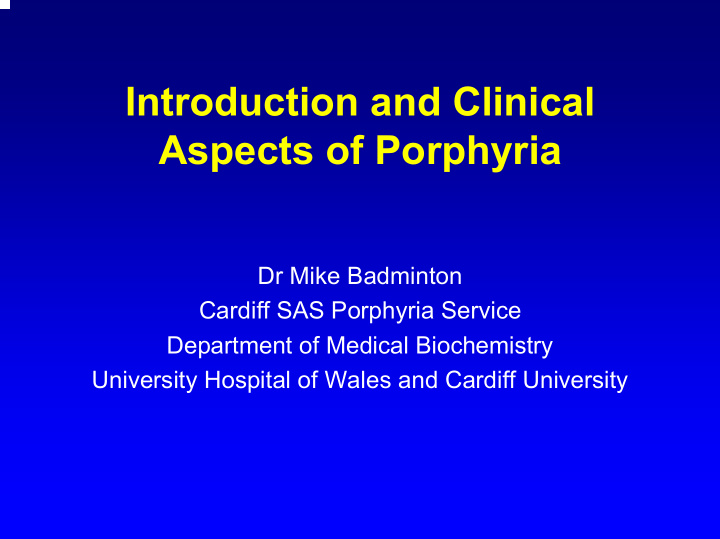



Introduction and Clinical Aspects of Porphyria Dr Mike Badminton Cardiff SAS Porphyria Service Department of Medical Biochemistry University Hospital of Wales and Cardiff University
OUTLINE • Introduction • The Acute Porphyrias • Cutaneous porphyrias – Bullous porphyrias – Erythropoietic protoporphyria • Cardiff Porphyria Services
Introduction • Group of disorders of haem biosynthesis • 7 different types • Acute porphyrias • Cutaneous Porphyrias • Skin symptoms and or acute attacks
Haem Biochemistry • Synthesised in all tissues – 80% for haemoglobin – 20% for enzymes (CytP450, catalase, peroxidase, tryptophan pyrrolase) • 8 enzymes in pathway • Intermediates (porphyrinogens) unstable • Porphyrinogens oxidise to porphyrins
Haem Biosynthesis Pathway Mitochondria Cytoplasm ALA ALA dehydratase Glycine synthase (ADP) + ALA PBG Succinyl PBG- CoA _ Deaminase (AIP) HAEM HMB Uro-Synthase (CEP) Fe 2+ Ferrochelatase (EPP) Uro’gen I Uro’gen III Protoporphyrin IX Uro-decarboxylase Proto’gen Copro’gen (PCT,HEP) Oxidase Oxidase (VP) (HCP) Copro’gen I Proto’gen IX Copro’gen III
Glycine + PORPHYRIA GENE Succinyl CoA ALA Synthase ALA Acute attacks ALA dehydratase ALA Dehydratase (ALAD, AIP, HCP, VP)* Deficiency Porphyria PBG Acute Intermittent Hydroxymethylbilane Porphyria synthase HMB Congenital Erythropoietic Uroporphyrinogen Porphyria Synthase Uroporphyrinogen III Bullous Skin lesions Porphyria Cutanea Tarda Uroporphyrinogen (CEP, PCT,HEP, HCP, Decarboxylase VP) Coproporphyrinogen III Hereditary Coproporphyrinogen Coproporphyria Oxidase Protoporphyrinogen IX Variegate Porphyria Protoporphyrinogen Oxidase Acute Protoporphyrin IX photosensitivity (EPP) Fe 2+ Erythropoietic Ferrochelatase Protoporphyria Haem
Secondary causes of increased porphyrins • Urine Coproporphyrin – Liver disease, drugs, fever, alcohol • Faeces Protoporphyrin – Constipation, GIT bleed, dietary (meat) • Blood Increased Zinc protoporphyrin – Lead poisoning, iron deficiency • Plasma – Renal failure, cholestasis
The Acute Hepatic Porphyrias Autosomal dominant Low penetrance (90% asymptomatic) Life threatening neurovisceral attacks Porphyria Type Prevalence Clinical Presentation Acute intermittent Commonest Acute neurovisceral attack Porphyria (AIP) 1-2:100,000 Hereditary Rarest i. Acute attack only (72%) coproporphyria <1:250,000 ii. Skin lesions only (7%) (HCP) iii. Both 21% 1:250,000 i. Acute attack only (20%) Variegate porphyria (VP) ii. Skin lesions only (59%) iii. Both (21%)
Acute Attacks Females>males (5:1) Rare before puberty Symptoms/signs Abdominal pain, Vomiting, constipation Psychiatric symptoms (anxiety, confusion, hallucinations) Hypertension, tachycardia, Convulsions: Motor neuropathy: Mild → severe (paralysis) Hyponatraemia
Treatment: Withdraw precipitating factor Symptomatic (opiates, anti-emetics etc) IV fluids (10% dextrose in N saline) Intravenous haematin (Haem arginate) Start treatment early (<24 hours) Problems: Thrombophlebitis Prognosis: Good, even with profound motor neuropathy
Management: Prevention Family studies to identify relatives at risk Avoid Known Precipitants: Sex hormones Unsafe drugs WMIC consensus “Safe list” (BNF = UNSAFE) www.porphyria-europe .com Alcohol, infection, dieting
THE CUTANEOUS PORPHYRIAS • Bullous porphyrias • PCT (HEP) • CEP • HCP and VP • Acute photosensitivity: - EPP
The Bullous Porphyrias • Skin lesions identical • Clues in clinical history – Age of presentation • Require biochemical investigation to distinguish • Essential for appropriate management – Definitive treatment (PCT, CEP) – Risk of acute attack (VP, HCP) – Family studies (VP, HCP)
Bullous Porphyrias: Clinical Manifestations • Fragile skin • Vesicles, bullae • Hypertrichosis • Other: • Milia, • hyper/hypopigmentation • scarring alopecia • sclerodermoid plaques
Porphyria Cutanea Tarda • Commonest porphyria (1:25,000) • Types – Acquired (Type I) 80% – Familial (Type II) 20% – (HEP= homozygous familial PCT) • Males 60% Females 40%
PCT: Pathogenesis • Inhibition of hepatic enzyme (UroD) • Exact mechanism unknown • Involves iron (>80% hepatic siderosis) • Predisposing factors –Alcohol –Prescribed oestrogens –Hepatitis C, HIV –Genetic haemochromatosis –(Renal failure)
PCT: Management • Avoid sunlight • Withdraw precipitants • Check hepatitis, transferrin saturation, HFE genotype • Choose definitive treatment – Venesection – Low dose chloroquine • Long term follow-up – Monitor liver function (hepatocellular carcinoma) – Monitor for relapse
Congenital Erythropoeitic Porphyria • Autosomal recessive • Defect in uroporphyrinogen III cosynthase • Variable phenotype: Infancy to adulthood • Clinical Manifestations – Extreme photosensitivity, scarring, mutilation – Hypertrichosis – Erythrodontia – Haemolytic anaemia, splenomegaly
CEP: Treatment • General – Avoid sunlight – Treat infections – Blood transfusion (+ DFO) • Specific – Bone Marrow Transplantation – (Gene therapy)
Erythropoietic protoporphyria (EPP) • Autosomal dominant, incomplete penetrance • ~ 1:150,000 • Ferrochelatase activity 10-40% • Mean age of onset 1 year (range 4/12 - 12 years) • Mean age at diagnosis 12 years! • Acute photosensitivity due to free protoporphyrin – 80% from bone marrow – 20% from liver
EPP: Clinical Acute Burning pain, oedema, relieved by cold “like a candle flame under skin” Chronic Linear scarring, thickened skin Management Sunlight avoidance Beta-carotene, Narrow band UV (311-313 nm) Regular follow-up Complications Liver dysfunction: Mild → fulminant liver failure → transplant Anaemia
Cardiff SAS Porphyria Service • Established by Professor George Elder • Deputy Director: Dr Sharon Whatley • Diagnosis of all types of porphyria – Biochemical testing (metabolites, enzymes) – Mutational analysis • Clinical service: Adult Metabolic Clinic: Acute porphyrias Dermatology Clinic: Cutaneous porphyrias • Teaching • Research interests – Epidemiology and genetics of EPP – Mitochondrial targeting of enzymes – Late onset erythropoietic porphyrias
Recommend
More recommend